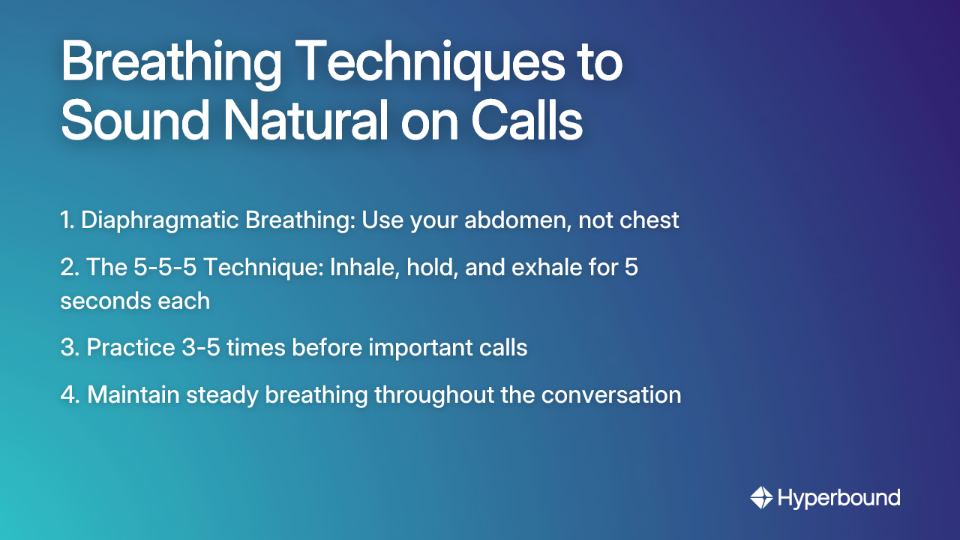
You've got your script ready. You know your product inside out. But the moment you dial that number, something changes. Your voice goes up an octave, your natural rhythm disappears, and suddenly you're trapped in what your manager calls "sounding salesy" - that dreaded robotic tone that screams "I'm reading off a script!"
If your mentors keep telling you to "relax and just have a conversation" but you're struggling to make that leap, you're not alone. The truth is, 70% of clients for sales professionals result from cold calls, yet many of us still battle with sounding like actual humans when making them.
The Mindset Shift: From Reading a Script to Guiding a Conversation
The problem with traditional scripts isn't the content—it's how they transform you into a passive reader rather than an active participant. When you're reading word-for-word, you're not really present. You're not listening. You're just waiting for your turn to speak the next memorized line.
Transform Your Script into Dot Points
One of the most effective techniques for sounding more natural is to deconstruct your script into a sequence of dot points instead of full written sentences. This simple change creates space for your natural voice to emerge.
For example, instead of:
"Hello, my name is John Smith from ABC Solutions. I noticed your company recently expanded into the European market, which is why I'm calling today. Our software has helped similar companies increase international sales by 30% in the first quarter."
Try a dot-point framework:

- Intro: [Name], [Company]
- Connection: Noticed European expansion
- Value prop: 30% sales increase for similar companies
- Question: How currently handling international orders?
This approach gives you the structure and reminders of key points without forcing unnatural phrasing. It allows your brain to formulate the actual words in real-time, just like in a normal conversation.
Shift Your Mindset from 'Reading' to 'Acting'
Stop thinking of your script as something to read and start seeing it as a conversation to bring to life. This mental shift is about internalizing the intent behind your points rather than memorizing exact words.
A quick fellow in sales once told me, "Pretend you're calling a friend!" This simple mindset trick immediately lowers the stakes and helps you snap out of that formal, salesy tone. When you call friends, you don't read from a script—you have points you want to make, but you deliver them conversationally.
Remember, your goal isn't perfect recitation; it's meaningful connection. With dot points guiding you instead of constraining you, you can focus on what the other person is saying and adapt accordingly.
Your Physical Toolkit: Mastering Body Language and Breathing on Calls
Here's something fascinating: research shows that 55% of communication is body language, 38% is vocal tone, and only 7% is the actual words spoken. But wait—if they can't see you on a phone call, why does body language matter?
Because your physical state directly impacts your voice. Your posture affects your diaphragm, which controls your breathing, which in turn shapes your vocal quality. The trick is to pretend the caller can actually see you.
Actionable Body Positioning
- Stand and Pace: Many successful sales professionals pace "like a maniac" during calls to maintain energy and sound passionate. Standing automatically projects a more confident tone and helps you avoid the monotonous delivery that comes with sitting still.
- Use a Headset: As one sales rep noted, "I go straight to shit if I have to hold an actual phone to my head." A good headset frees your hands, allowing for natural gestures that, believe it or not, will come through in your voice.
- The Big Smile: Before speaking, put on a genuine smile. This physical adjustment literally changes the shape of your vocal tract, creating a warmer, more approachable tone. The listener won't see your smile, but they'll hear it.
- Good Posture: If you must sit, sit up straight. Slumping constricts your voice, making you sound tired or uninterested—not exactly the state of calm confidence you want to project.
Breathing Techniques to Banish Nerves
Nervousness is the enemy of natural conversation. The quickest way to regain control is through your breath:

- Diaphragmatic Breathing:
- Place one hand on your chest and the other on your abdomen
- Breathe in deeply through your nose, ensuring your abdomen rises while your chest remains still
- Exhale slowly through slightly pursed lips
- Practice 5-10 times before calls to center yourself
- The 5-5-5 Technique:
- Inhale for 5 seconds
- Hold for 5 seconds
- Exhale for 5 seconds
- Repeat 3 times before dialing
When your breathing slows, your heart rate follows, and your voice naturally becomes more steady and authoritative—essential qualities for building rapport with C-level appointments.
Practical Exercises to Find Your Natural Voice
Voice modulation—the art of varying your pitch, pace, and volume—is what separates robotic script-readers from engaging conversationalists. Here are practical exercises to develop a more dynamic, natural speaking voice:
Vocal Warm-Ups (Do These Before Your Calling Block)
- Jaw Release: Gently massage the facial muscles by pressing in and out from the cheekbones down to the jaw. This releases tension that can make your voice sound strained.
- Lip Trills: Create a motorboat sound ("brrrr") with your lips. This connects breath to voice and warms up your facial muscles.
- Humming: A simple "mmmm" sound, focusing on the vibration in your lips and nose, helps relax the vocal cords and prepare them for speaking.
Mastering Pitch, Pace, and Volume
- The Pitch Elevator:
- Choose a simple phrase like "How are you today?"
- Say it five times, starting at your normal pitch, then moving higher, then lower
- Notice how different pitches convey different emotions and intentions
- Practice ending statements with a downward pitch (authoritative) and questions with an upward pitch (engaging)
- Pace Control:
- Record yourself reading your dot points at your normal pace
- Now practice the same content but deliberately slow down at key points
- Remember: when you get to the point quick, you maintain interest, but strategic slowdowns emphasize important information
- The Power of the Pause:
- After making an important point, pause for 2-3 seconds
- This gives the listener time to absorb what you've said
- It also demonstrates confidence—rushing suggests nervousness
- Volume Variation:
- Slightly increase your volume when emphasizing key benefits
- Slightly decrease volume when asking questions to encourage the prospect to lean in and engage
These exercises help you break out of script autopilot and bring those words to life in a way that sounds authentic and engaging.

Putting It All Together: Practice, Application, and Reflection
The bridge between theory and mastery is deliberate practice. Here's how to integrate everything we've covered:
Record and Analyze Your Practice Calls
This step is non-negotiable if you want to improve. While recording yourself practicing your dot-point framework is a great start, AI-powered tools can supercharge your progress.
Platforms like Hyperbound's AI Sales Roleplays provide a safe, repeatable environment to practice against realistic AI buyers. Instead of just listening back on your own, these systems offer objective feedback on:
- Where you sound unnatural
- Whether you are rushing or pausing effectively
- If your tone is consistently engaging
- How well you are hitting your key talk tracks
This deliberate practice is the fastest way to build muscle memory for natural, effective conversations.
Create an Adaptable Script Structure
Your dot points should follow a clear structure:
- Introduction (10 seconds): Who you are
- Connection (10 seconds): Personalized comment showing you've done research
- Purpose (10 seconds): BS reason for the call (the small problem you're addressing)
- Engagement: Open-ended question to start the conversation
This structure helps you get to the point quick while still sounding conversational.
Focus on Active Listening
Sounding natural is a two-way street. The most authentic-sounding salespeople are excellent listeners:
- Ask open-ended questions
- Use affirming words like "I see," "That makes sense"
- Reference information the prospect shared earlier in the call
This approach helps you handle objections with confidence because you're truly engaging with the prospect's concerns rather than jumping to the next bullet point.
Post-Call Reflection
Take 60 seconds after each call to ask yourself:
- Did I sound like a human or a robot?
- Where did the conversation flow naturally? Where did it feel forced?
- What objections caught me off guard?
- Did I maintain my natural speaking voice throughout?
The Ultimate Goal: Act Like a Human
The irony of "sounding natural" is that it requires practice and preparation. But with the right approach—transforming scripts into adaptable dot points, using your body and breath to project confidence, and regularly practicing vocal exercises—you create the foundation for authentic conversations.
Remember, people don't buy from salespeople who sound salesy. They buy from people they connect with. When you speak with your authentic voice, maintain a big smile, and genuinely listen, you're not just making a call—you're building a relationship. And in sales, that makes all the difference.
By mastering these techniques, you'll transform from someone reading a script to someone guiding a conversation—someone who sounds like a trusted advisor rather than just another salesperson trying to make a quick commitment. So take a deep breath, stand up, smile, and let your natural voice lead the way to your next successful cold call.

Frequently Asked Questions
Why do I sound robotic on sales calls?
You likely sound robotic because you are focusing on reading a script word-for-word instead of guiding a natural conversation. This focus on recitation removes your authentic vocal tone and rhythm, making you sound rehearsed. The solution is to internalize your key points and deliver them conversationally, rather than just reading lines.
How can I use a script without sounding salesy?
The most effective method is to transform your full-sentence script into a dot-point framework. This provides the key talking points—like your introduction, value proposition, and questions—without locking you into unnatural phrasing. This structure allows you to formulate sentences in real-time, adapting to the flow of the conversation.
Does my body language matter on a phone call if they can't see me?
Yes, your body language directly impacts your vocal tone and quality, even when you're not on video. Your posture affects your breathing, which controls the power and confidence in your voice. Standing up, using a headset to free your hands for gestures, and even smiling can create a more energetic, warm, and approachable tone that listeners can clearly hear.
What are the best breathing exercises to calm nerves before a cold call?
The best techniques are Diaphragmatic Breathing and the 5-5-5 Technique, as they slow your heart rate and steady your voice. For Diaphragmatic Breathing, breathe deeply using your abdomen, not your chest. For the 5-5-5 Technique, simply inhale for five seconds, hold your breath for five seconds, and exhale for five seconds. Repeating this 3-5 times before a call can significantly reduce nervousness.
How can I practice my sales pitch to sound more natural?
The best way to practice is by recording yourself and analyzing your performance, ideally using a safe environment like an AI roleplay tool. Recording your calls helps you identify where you sound robotic or rushed. AI sales roleplay platforms provide a space to practice against realistic buyer personas and receive objective feedback on your pace, tone, and engagement without risking real customer relationships.
Should I stand up or sit down during sales calls?
Standing is often recommended because it helps project a more confident and energetic tone. When you stand, your posture improves, allowing for better breath support from your diaphragm, which leads to a stronger voice. Pacing can also help maintain energy. If you must sit, ensure you sit up straight to avoid constricting your voice.
What is the power of the pause in sales?
The strategic use of the pause is one of the most powerful vocal techniques for sounding engaging and authoritative. Pausing for 2-3 seconds after making a key point or asking a question demonstrates confidence and gives the listener time to process information. It prevents you from rushing—a common sign of nervousness—and makes your delivery more thoughtful.
Book a demo with Hyperbound
.png)













